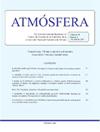Statistical analysis of the relationship between Quasi-Biennial Oscillation and Southern Annular Mode
IF 1
4区 地球科学
Q4 METEOROLOGY & ATMOSPHERIC SCIENCES
引用次数: 1
Abstract
The Southern Annular Mode (SAM) is an extratropical pattern that influences the climate of all Southern Hemisphere. However, the variability of this mode is an active area of research. The influence of lower frequency modes on SAM is a path to better knowledge about this pattern. The relationship between Quasi-Biennial Oscillation (QBO) and SAM’s counterpart in the Northern Hemisphere (Northern Annular Mode) has been addressed by previous work. Still, few studies focus on the association between QBO and SAM. The goal of this work was to evaluate the possible QBO-SAM relationship through statistical analyses. This association was investigated by comparing QBO and SAM indices, the latter on different levels of the troposphere and stratosphere, for the 1981-2010 period. The wavelet analysis showed that the SAM indices for troposphere and stratosphere presented variability in many scales, including a two-year band. Cross-wavelets techniques between QBO and SAM ratified that this relation has a complex interaction. There was a significant common high power around the two-year band, with lags varying over the analyzed period, including no lag. Further analysis without lag confirmed previous studies, indicating that the negative (positive) SAM phase is more frequent for easterly (westerly) QBO. However, this was not valid for all months. Some additional analysis suggested that the upward wave propagation to the stratosphere for each QBO phase changes the stratospheric jet and, consequently, the SAM phase.准两年一次振荡与南环模关系的统计分析
南部环形模式(SAM)是一种影响整个南半球气候的温带模式。然而,这种模式的可变性是一个活跃的研究领域。低频模式对SAM的影响是更好地了解这种模式的途径。准两年振荡(QBO)和SAM在北半球的对应振荡(北环形模式)之间的关系已经在以前的工作中得到了解决。尽管如此,很少有研究关注QBO和SAM之间的关系。这项工作的目的是通过统计分析来评估QBO-SAM之间可能的关系。通过比较1981年至2010年期间对流层和平流层不同水平的QBO和SAM指数,对这种关联进行了研究。小波分析表明,对流层和平流层的SAM指数在多个尺度上表现出变化,包括两年带。QBO和SAM之间的交叉小波技术证实了这种关系具有复杂的相互作用。在两年的波段周围有一个显著的共同高功率,在分析的时期内有不同的滞后,包括没有滞后。没有滞后的进一步分析证实了先前的研究,表明负(正)SAM阶段对东风(西风)QBO更为频繁。然而,这并不是所有月份都有效。一些额外的分析表明,每个QBO阶段向平流层的向上波传播会改变平流层喷流,从而改变SAM阶段。
本文章由计算机程序翻译,如有差异,请以英文原文为准。
求助全文
约1分钟内获得全文
求助全文
来源期刊

Atmosfera
地学-气象与大气科学
CiteScore
2.20
自引率
0.00%
发文量
46
审稿时长
6 months
期刊介绍:
ATMÓSFERA seeks contributions on theoretical, basic, empirical and applied research in all the areas of atmospheric sciences, with emphasis on meteorology, climatology, aeronomy, physics, chemistry, and aerobiology. Interdisciplinary contributions are also accepted; especially those related with oceanography, hydrology, climate variability and change, ecology, forestry, glaciology, agriculture, environmental pollution, and other topics related to economy and society as they are affected by atmospheric hazards.
 求助内容:
求助内容: 应助结果提醒方式:
应助结果提醒方式:


